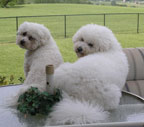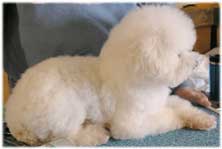|

SCISSORING PETS PRETTY
( TECHNIQUES FOR COIFFING YOUR PET)
by Barbara Bird

|
|
Dip and Snip ?
Many novice groomers use what I call the "Dip &
Snip" technique of scissoring. Dipping is when you move in and out of
the surface to be scissored. The groomer takes a cut and then pulls the
shears away and then dips in for another cut. Snipping is using the top
third of the scissor blades only. Are you guilty? Don't feel bad. Most
of us start out with this technique until corrected. It is natural to
dip and snip when you are being tentative and lack confidence.
|
Get a Grip - lose the index finger!
Uh oh! You picked up your grooming shears just as
you always have done with other scissors and hooked your thumb in the
bottom ring and your pointer or index finger in the top ring? Wrong!
Bad! The scissor police will get you for that. First of all, no hooking.
REST your thumb alongside the thumbnail in the lower ring. Don't stick
it in up to the first joint. We are trying to create a "fulcrum" here.
The fulcrum is the leverage point where you get the most control and
balance for use of your tool with the least amount of effort. It's a
good thing. Now instead of sticking your index finger through the top
ring, place it along the shank of the shears. The shank is the lower
part below the blades. Now you are starting to have some control. Place
your ring finger in the upper ring, and rest your pinky on the loopy
thing. It's called a finger rest. Get it? Place your middle finger
gently below the index finger. There you go, the "proper" way to hold
your shears. There is another position which some of us find more
comfortable. Place your middle finger in the top ring and rest the ring
finger alongside the pinky which is in the finger rest. This is the grip
that I use. It is second-best, but acceptable. Most important is to get
your index finger out of the ring. Until you do that, you will be
scissoring with a pinching action that will keep you snipping and
dipping.
|
Twelve O'Clock and All is Well
Hold your shears with the blades straight up in the
12 O'clock position. There you have it! This is the main position from
which you will be doing most of your scissoring. The reason for scissoring
up into the coat as much as possible is that the scissoring action moves
the coat slightly forward and ahead of the shears. If you are scissoring
downward, it is like slightly patting the coat down as you go. This
requires more combing back up to get the finish you want |
|
Exercise One:
Hold your shears straight up in the 12 O'Clock position. Using your
thumb only, open and close your scissor blades to the "5 to 1" position.
Work on get the exact same time on the imaginary clock with every
opening of the blades. Now go to the "10 to 2" position and do the same
thing. The goal is consistency in your scissoring action. For most of
your scissoring, you will be making cuts from the "10 to 2" position. In
smaller areas, you will use the "5 to 1." Either way, you need to
strengthen your thumb to do the work. Avoid pinching the blades together
with the fingers and thumb. The point is to get full cuts using nearly
all the length of the blades.
|
Exercise Two:
Hold your shears in the 12 O'clock position and place your hand parallel
to a wall. Practice opening and closing the blades while moving from right
to left and back, but staying parallel to the wall at the exact distance.
Now open and close your blades while rotating your wrist to the 3 PM
position. Practice staying on a level plane and not dipping. Use light
pressure with your index finger on the shank to maintain control of the
positioning of the shears. Try stretching your reach from the 3 PM
position all the way to 6 PM Work the other way as well, from 12 to 9 and
down to 6. This requires you to develop flexibility in your wrist. It is
important to also work on your control and stay parallel to the wall. |
Cuts per minute
This is the rpm's of your scissoring machine. If
you listen to competition groomers or Edward Scissorhands, their scissors
are clicking faster than you can count. It sounds like a machine. It is
not necessary to have the speed of a race car, you can settle for
cruising, as long as you get the motor going. You want even and consistent
action of the scissor blades. This will help keep you from dipping the
scissors in and out of the coat. By increasing the number of cuts over a
given surface of coat, you will get a smoother finish. Find the cpm speed
that works for you. |
Exercise Three:
Hold the shears in the 12 o'clock position and move from 12 to 3 o'clock
while making long, even, cutting strokes. Work that thumb! Now count your
strokes and try to get 10-15 cuts in while covering that area. Work on
increasing the cpm as well as opening the shears the full length of the
blades |
That's It!
Good scissoring technique is a matter of (a) holding
the shears correctly so as to create a solid fulcrum, (b) working the
thumb to open and close the blades, (c) using nearly all the length of the
blade (no snipping), (d) hand control to stay on a level plane (no
dipping), (e) wrist flexibility, and (f) getting up to speed (cuts per
minute). Now all you have to do is move away from the wall and on to the
living, probably moving, target.
There are two other factors that will influence the
results of your scissoring efforts: the shears themselves and the coat
preparation. It is important to use high quality professional instruments
that have been maintained at peak sharpness. A cheap or dull shear will
bend the hair rather than cut it. Give your shears the Tissue Test. Hold
a piece of tissue loosely with one hand and cut into it with the shears.
You should get clean easy cuts, no bending, tearing or snagging of the
tissue. In order to achieve a smooth sculpted groom, such as the Bichon
Frise, most groomers use 8" or 10" shears. The longer length blade
requires fewer cuts, covering a larger area. Curved shears are helpful
for getting rounded heads, butts, and defining angulation. The hair needs
to be clean and fluffed out, preferable "fluff dried" which is a brushing
while drying technique. Fluff the coat using a metal comb, scissor an
area, fluff AGAIN, and rescissor the area. It may take several passes
over an area to get it perfect. |
Scissoring technique does not happen overnight. It
takes considerable practice to gain the control needed. Be patient with
yourself and use the exercises above. The more you practice, the quicker
you will learn. Happy grooming! |
|
|
About the
Author
Barbara Bird, owner of Transformation Pet
Health Center, has been grooming for 30 years in Tucson Arizona.
Barbara learned the
art of fine grooming through an extended apprenticeship to Bill "Scissorhands"
North, to whom she owes a lifetime debt and an inferiority complex.
Barbara offers
"Specialized Grooming"
Barbara specializes in hand scissored trims, custom
pet styling and hand stripping of small terrier breeds. She also enjoys
tackling large, undercoated, breeds. Barbara belongs to the NDGAA, ISCC
and is certified in non-sporting breeds through the NDGAA. While sometimes
tired, she is rarely burned out and retains a passion for helping people
with their pet care. Links to other articles about pet care and grooming
can be found at:
http://www.Transformationpet.com.
CONTACT THE AUTHOR:
Transformation Pet Health Center
Tucson, AZ
Phone: 520-795-5743
e-mail:
petpals@azstarnet.com
|
| |
| |
| |
| |


